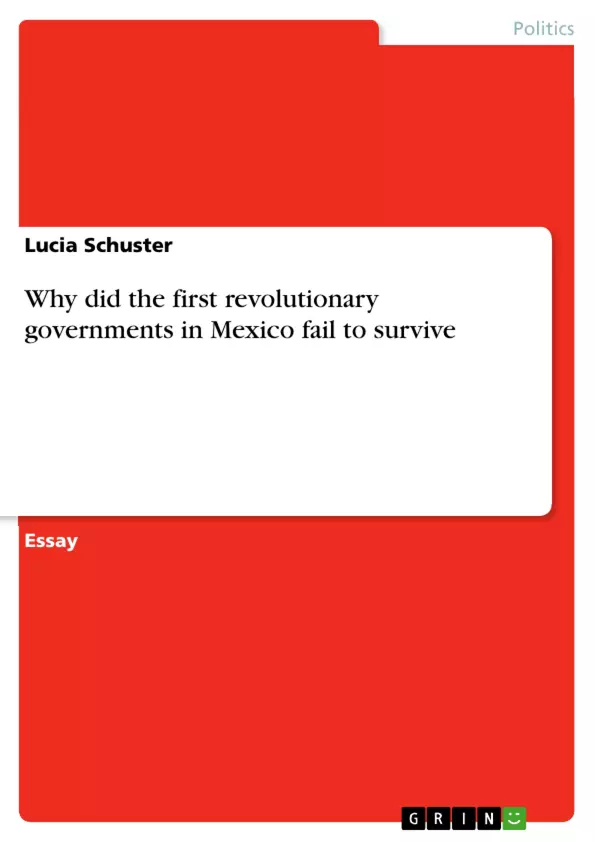In the years from 1911 to 1934 Mexico witnessed fifteen presidents1 appearing and vanishing
after short periods of rule. The political, economic and social reasons for such a rapid change
in governmental affairs will be discussed in this essay. Governments can be defined as
“institutions responsible for making collective decisions for society. More narrowly,
government refers to the top political level within such institutions” (Hague R., p. 5). It is
suitable to evaluate the question of governmental survival on the background of an official
period of four years till 1926 and from then on of six years. This makes it possible to
recognise that the rulers in Mexico during the first 33 years following the revolution were not
capable of remaining in power for a whole term and/or did not survive their removal from
office in a literal sense. All those governments never reached the political stability in order to
consequently produce a lasting regime. This essay will firstly deal with factors which can be
applied as reasons for all regimes to some degree such as competition for power, opposition,
failure to reform and a discontent population. Secondly some remarkable impediments weigh
more heavily on specific regimes such as personal incompetence or foreign and clerical
pressure, which made it even more difficult for them to persist. To answer the addressed
question of this work, I will focus on President Madero, Huerta, Carranza, Obregón and
Calles in order to represent convincing explanations for their failure to survive, exemplifying
arguments for all regimes till Lazaro Cardenas. The reasons, which should be considered of great albeit varying significance for the failure of
all the disappointing and short lived rulers succeeding the dictator Díaz, will be discussed in
the first part of this paper. Power struggles within the ruling elite, severe opposition,
economical difficulties and the failure to reform, a discontent population and its resulting
political obstacles caused the problem of unsolved political instability which was those
governments undoing. [...]
1 15 presidents from Francisco Leon de la Barra (interim) 1911 to Abelardo L. Rodriguez (interim) 1932-1934;
http://www.northcoast.com/~spdtom/rev3.htm
Inhaltsverzeichnis (Table of Contents)
- Factors Leading to Governmental Failure
- Power Struggles Within the Ruling Elite
- Opposition Movements
- Economic Difficulties and Failure to Reform
- Discontent Population
- Impediments Weighing More Heavily on Specific Regimes
- Personal Incompetence
- Foreign and Clerical Pressure
Zielsetzung und Themenschwerpunkte (Objectives and Key Themes)
This essay explores the reasons behind the failure of the first revolutionary governments in Mexico to survive, particularly focusing on the period between 1911 and 1934. It examines the political, economic, and social factors that contributed to the rapid turnover of presidents during this turbulent period. The essay analyzes the impact of internal power struggles, opposition movements, and the failure to address key social issues like land reform on the stability of these regimes.
- Internal Power Struggles and Betrayals
- Opposition Movements and Armed Rebellions
- Economic Challenges and Failure to Implement Reforms
- Discontent Population and Social Unrest
- Personal Incompetence and Foreign Interference
Zusammenfassung der Kapitel (Chapter Summaries)
The essay examines the impact of various factors on the failure of different regimes, particularly focusing on President Madero, Huerta, Carranza, Obregón, and Calles. It explores how power struggles within the ruling elite, often fueled by ambition and opportunism, undermined the stability of these regimes. The essay also highlights the role of strong opposition movements, led by figures like Pancho Villa and Emiliano Zapata, who fought against the governments' failure to address their grievances. It further analyzes how economic difficulties, the inability to implement meaningful reforms, and the presence of a discontented population contributed to the instability and short lifespan of these governments.
Schlüsselwörter (Keywords)
The essay revolves around the themes of political instability, power struggles, opposition movements, land reform, and economic challenges in post-revolutionary Mexico. It examines the role of key figures like Madero, Huerta, Carranza, Obregón, and Calles in shaping the political landscape and the dynamics of power during this turbulent period.
- Citar trabajo
- Lucia Schuster (Autor), 2002, Why did the first revolutionary governments in Mexico fail to survive, Múnich, GRIN Verlag, https://www.grin.com/document/13834



